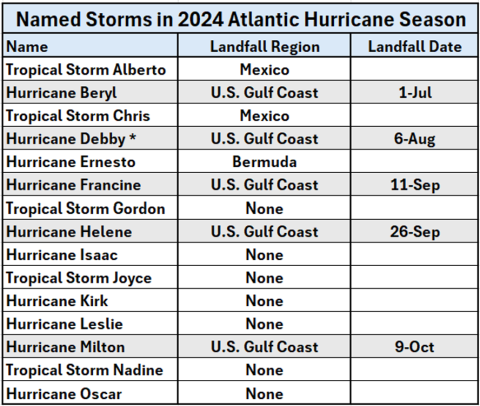As the Atlantic hurricane season churns out storms that regularly threaten the U.S. Gulf Coast, it can be easy to forget that the East Coast — an important refining center and refined-products market — is not immune from their impact. A dozen years ago this month, Superstorm Sandy roared ashore in New Jersey, wreaking havoc with storm surges and fierce winds that stretched for 1,000 miles. While the East Coast lacks the Gulf Coast’s concentration of energy infrastructure, it is home to the critical New York Harbor (NYH) market. In today’s RBN blog, we will examine how storms have affected the refining sector on the East Coast.
Before we review the impact that storms have had along the Eastern Seaboard, let’s look at what the hurricane season — which runs from June 1 through November 30 — has dished out this year. Five hurricanes (gray-shaded rows in Figure 1 below) have struck the U.S. Gulf Coast (USGC), of which three (Beryl, Helene and Milton) were major hurricanes, although they may have weakened before landfall. Just so we understand what that means, sustained winds define a hurricane’s strength on the Saffir-Simpson scale in five categories: a Category 1 storm has wind speeds of 74-95 miles per hour (mph) while a Category 5 is 157 mph or higher; major storms are those in Category 3-5, where wind speeds reach and exceed 111 mph.
Figure. 1. Named Storms in 2024 Atlantic Hurricane Season. Source: National Hurricane Center.
Note: Gray-Shaded Rows Indicate Storms That Made a U.S. Landfall
* Debby Made a Second Landfall in South Carolina
In Riders on the Storm, we discussed how Hurricane Beryl disrupted some offshore Gulf of Mexico (GOM) production in July when it swept through, but operations recovered soon after. However, the Category 1 storm knocked out power for weeks in some areas after coming ashore near Matagorda, TX. The slightly stronger Hurricane Francine made landfall in Louisiana two months later, and we examined in Gimme Shelter how its impact on power supply had a knock-on effect on GOM operations. At its height, more than 40% of offshore oil output was shut until power was restored to onshore downstream facilities.
Join Backstage Pass to Read Full Article








